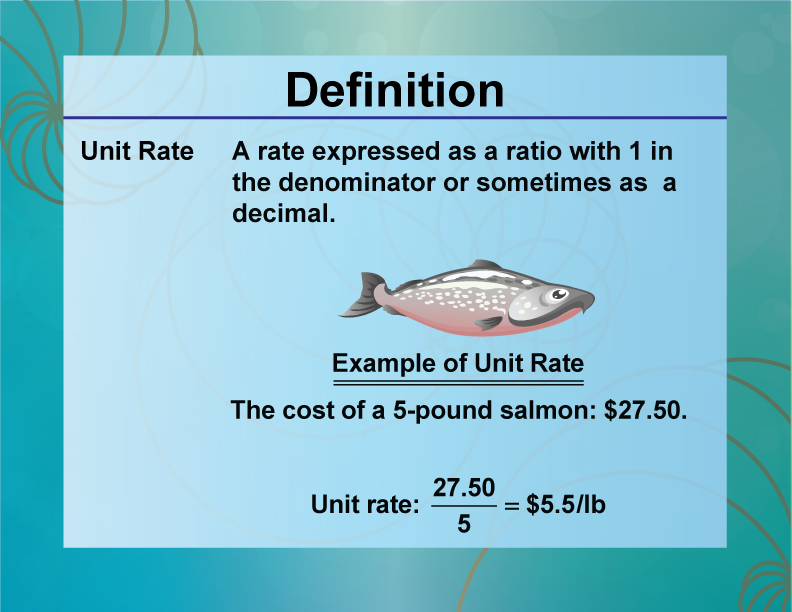
Display Title
Definition--Ratios, Proportions, and Percents Concepts--Unit Rate
Display Title
Unit Rates
Watch the following video to learn about unit rates. (The video transcript is included.)
Video Transcript
Rates are an important type of ratio because they often measure something important. Unit rates are particularly important because you can use a unit rate to measure any value based on that rate.
In this video we look at unit rates and how they can be used to solve problems.
Let's look at an example.
Three pounds of bananas cost $2.25. Find the unit rate for the cost of bananas.
Use the unit rate to find what the cost of 10 pounds of bananas would be.
We know what three pounds of bananas cost, but how do we determine how much one pound costs? For that we need a unit ratio.
A unit ratio is simply a ratio when, in fraction form, has a denominator of 1. And the simplest way to get to a unit rate is to divide numerator by the denominator.
Take the ratio 2.25/3 and divide 2.25 by 3. We get 0.75 dollars/pound. In other words, the unit rate is 75 cents a pound.
With this unit rate, we can calculate the cost for any amount. So the cost of 10 pounds of bananas is 10 times the unit rate or 10 times 0.75 dollars/pound, for a total of $7.50.
Unit rates are an important part of our everyday use of mathematics. Let's look at another example.
A barista earned $150 for a 7 1/2-hour shift. What was the hourly rate, expressed as a unit rate?
How much does the barista earn in a 40-hour work week?
Take the numerical ratio 150/7.5 to find the unit rate. Also, make a note of the units, dollars/hour.
We get a unit rate of $20/hour.
For 40 hours, we multiply $20/hr times 40 hours.
So, the barista earns $800 in a 40-hour week.
Notice when multiplying $20/hr times 40 hours, the hours units cancel out and you’re left with dollars.
We can also use unit rates to convert from one type of unit to another. Let's look at an example.
What is the unit conversion rate to convert miles to kilometers?
Use that unit rate to convert 29.5 miles to kilometers.
The unit conversion rate to go from miles to kilometers is 1.60934 kilometers/mile
To convert x miles to kilometers, multiply by this unit rate.
So let's convert 29.5 miles to kilometers:
29.5 miles x 1.60934 kilometers/mile
What we get is 47.47553 kilometers.
Unit conversion rates are used quite a lot. They allow for converting measurement, amounts of money, and many other applications.
The downloadable image is part of a collection of definitions related to ratios, proportions, and percents. This includes general definitions for ratios, proportions, percents, as well as terms related to similarity, proportionality, and equivalence of ratios.
Note: The download is a PNG file.
Related Resources
To see additional resources on this topic, click on the Related Resources tab.
Create a Slide Show
Subscribers can use Slide Show Creator to create a slide show from the complete collection of math definitions on this topic. To see the complete collection of definitions, click on this Link.
To learn more about Slide Show Creator, click on this Link:
Accessibility
This resources can also be used with a screen reader. Follow these steps.
-
Click on the Accessibility icon on the upper-right part of the screen.

-
From the menu, click on the Screen Reader button. Then close the Accessibility menu.

-
Click on the PREVIEW button on the left and then click on the definition card. The Screen Reader will read the definition.
| Common Core Standards | CCSS.MATH.CONTENT.6.RP.A.1, CCSS.MATH.CONTENT.6.RP.A.2, CCSS.MATH.CONTENT.6.RP.A.3, CCSS.MATH.CONTENT.7.RP.A.3, CCSS.MATH.CONTENT.HSG.SRT.A.1.B |
|---|---|
| Grade Range | 6 - 8 |
| Curriculum Nodes |
Algebra • Ratios, Proportions, and Percents • Ratios and Rates |
| Copyright Year | 2021 |
| Keywords | ratios, Percent, definitions, glossary terms, rates, proportions |